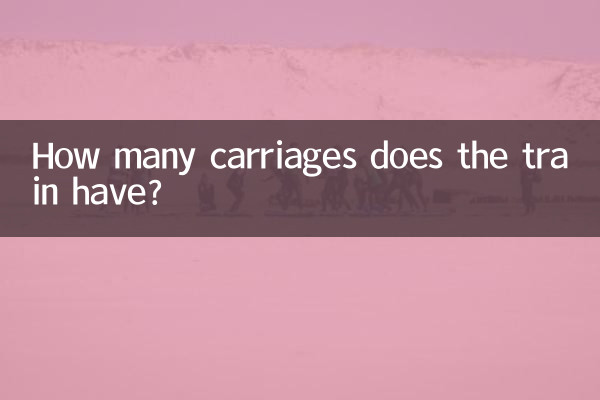How many carriages does the train have? Demystifying the secrets of rail transport
In the past 10 days, discussions about the number of train carriages have attracted widespread attention on social media. As railway transportation continues to develop, people's curiosity about train construction is also growing. This article will start from hot topics and combine structured data to provide you with a detailed analysis of the mystery of the number of train carriages.
The basic composition of the number of train cars

The number of train carriages is not fixed, but can be flexibly adjusted according to factors such as vehicle type, purpose and line conditions. The following are statistics on the number of carriages in several common types of trains:
| Train type | Common number of carriages (sections) | Remark |
|---|---|---|
| High-speed rail (EMU) | 8-16 | Some long trains can reach up to 17 cars |
| Normal speed passenger train | 15-20 | Including hard seats, hard sleepers, soft sleepers and other carriages |
| freight train | 30-50 | Some heavy-haul trains can reach more than 100 knots |
| Metro/light rail | 4-8 | Flexible grouping according to passenger flow |
The science behind the number of carriages
The number of carriages in a train is not set arbitrarily but is strictly calculated. First of all, power configuration is a key factor in determining the number of carriages. For example, high-speed rail EMUs usually adopt a "power-dispersed" design. Each carriage or part of the carriages has its own power, so the number of groups can be more flexible.
Secondly, platform length and line conditions will also limit the number of carriages. The platform length of most high-speed rail stations in China is 450 meters, which can accommodate 16-car trains. Freight trains usually run on dedicated lines and are not restricted by platform length, so the number of carriages can be larger.
Hot topic: Why are high-speed rail usually 8 or 16 knots?
In the past 10 days, the Weibo topic #Why does high-speed rail have 8 or 16 sections? #has become a hot search topic. Experts explain that this is related to the standardized design of my country’s high-speed rail. The 8-section formation is the basic unit and is called a "short formation"; the 16-section formation is formed by connecting two short formations and is called a "long formation". This design facilitates scheduling and maintenance, and can also adapt to different passenger flow needs.
| High-speed rail marshalling type | Representative models | Applicable scenarios |
|---|---|---|
| 8-section short formation | CRH380A | Lines with low daily traffic |
| 16 sections long formation | CR400BF | Busy arterial lines such as the Beijing-Shanghai high-speed railway |
| 17 sections super long formation | CRH2G | Special line requirements |
"Big Mac" formation of freight trains
Unlike passenger trains, freight trains tend to have an even more impressive number of carriages. On heavy-haul lines such as the Daqin Railway, freight trains of more than 100 cars can often be seen. This type of "10,000-ton train" is usually pulled by Harmony electric locomotives and transports bulk commodities such as coal.
It is worth mentioning that the topic # longest train challenge # on Douyin has become increasingly popular recently. Some netizens photographed the 3-kilometer-long freight train, which sparked onlookers. In fact, this kind of ultra-long marshalling is a reflection of railway transportation efficiency, reducing unit energy consumption through centralized transportation.
Future development trends
As technology advances, there may be new changes in the number of train cars. For example, variable marshalling EMUs have been put into trials, which can adjust the number of carriages in real time according to passenger flow. In addition, new forms of transportation such as maglev trains may also break the traditional limit on the number of carriages.
In summary, the number of train carriages is the result of the precise design of the railway transportation system, taking into account both technical factors and economic benefits. From the standard formation of high-speed trains to the extra-long formation of freight trains, every carriage carries the wisdom of modern transportation.

check the details

check the details